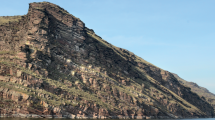Abstract
This paper analyzes – chemically, mineralogically, and petrolographically – the patinas developed on several Mediterranean monuments made with different stones (siliceous and carbonatic) in order to establish their origin and their evolution under the present environmental conditions, and to evaluate the environmental parameters controling their development. Most of the patinas show a common sequence of layers, which, from the outer to the inner zone, are: (1) present bioactivity and/or biological remains, (2) gypsum-rich patina, and (3) calcitic brown to orange patina. Each one may exhibit different fabrics (from micritic to stromatolitic) and may be more or less continuous and homogeneous. The main mineral components are calcite and gypsum, but Ca-oxalates and Ca-phosphates have also been found associated to biological structures, as well as quartz and clays. The different fabrics and textures have been interpreted as consequence of changes in the environmental conditions which seem to be related to the biological activity, facilitating the growth of different organisms and leading to the development of a deposit with distinct characteristics (fabric, texture, porosity, etc.). The gypsum-rich patina has been interpreted as a sulphation of the underlying calcitic layer by the action of atmospheric pollutants or as dry or wet deposition from the atmospheric dust. The mineralogy and texture of the patina is independent of the nature of the underlying rock and only in few cases a micritization process has been observed as interaction between patina and rock. Recently, the penetration of endolithic microflora produced drillings and the development of a fissuration system parallel to the surface, and thus the detachment of the crust from the rock and even flackening of the rock itself has been observed. Consequently, under the present climatic conditions in the Mediterranean basin, erosion is a more active process than deposition, and the crusts and patinas show a tendency to disappear from the surface of the monuments.
Similar content being viewed by others
Author information
Authors and Affiliations
Additional information
Received: 3 November 1996 · Accepted: 10 September 1997
Rights and permissions
About this article
Cite this article
Garcia-Vallès, M., Vendrell-Saz, M., Molera, J. et al. Interaction of rock and atmosphere: patinas on Mediterranean monuments. Environmental Geology 36, 137–149 (1998). https://doi.org/10.1007/s002540050329
Issue Date:
DOI: https://doi.org/10.1007/s002540050329




